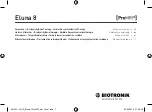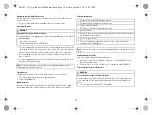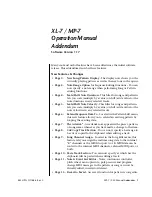
en • English
3
Device types
For the following symptoms/expectations, the following device types are indicated:
Pacing modes
For the following symptomatic, the following pacing modes are indicated:
MR conditional
ProMRI
®
labeled MRI conditional pacemakers are safe for use in the MRI environment
when used in conjunction with a complete MRI conditional pacing system and according
to the instructions given in the ProMRI® manual.
Contraindications
Guidelines
No contraindications are known for the implantation of multifunctional single-
chamber, dual-chamber or triple-chamber devices, provided differential diagnostics
precedes implantation according to the appropriate guidelines and no modes or
parameter combinations are configured that pose a risk to the patient.
Pacing modes and parameters
The compatibility and effectiveness of parameter combinations must be checked and,
as the case may be, adapted after programming.
Symptom/expectation
SR
DR
HF
Disorientation due to bradycardia
x
x
x
Presyncope x
x
x
Benefit from resynchronization of the right and
left ventricles
x
Syncope
x
x
x
Symptom/expectation
Pacing mode
Sick sinus syndrome
Dual-chamber pacing
Chronic, symptomatic second and third-degree AV block
Dual-chamber pacing
Adams-Stokes syndrome
Dual-chamber pacing
Symptomatic bilateral bundle branch block when tachy-
arrhythmia and other causes have been ruled out
Dual-chamber pacing
• Chronotropic incompetence
• Benefit from increased pacing rate with physical
activity
R mode or CLS
Sinus node dysfunction in the presence of normal AV and
intraventricular conduction
Atrial pacing
Bradycardia in conjunction with the following:
• Normal sinus rhythms with only rare episodes of AV
block or sinus arrest
• Chronic atrial fibrillation
• Severe physical disability
Ventricular pacing
Set of facts
Contraindicated pacing mode
Additionally implanted ICD
Unipolar pacing
Set of facts
Inappropriate pacing mode
Chronic atrial tachycardia, chronic atrial
fibrillation or flutter
Atrial-controlled modes (DDD, VDD, AAI)
Poor tolerance of pacing rates above the
basic rate, e.g., angina pectoris
AV conduction disorder
Atrial single-chamber pacing
Failing AV conduction
Set of facts
Adapt parameters
Slow retrograde conduction after ventric-
ular pacing: Risk of pacemaker-mediated
tachycardia
• Extend atrial refractory period (ARP)
and/or:
• Shorten AV delay
• Rarely:
Program to DDI, DVI or VVI
Poor tolerance of pacing rates above the
basic rate, e.g., angina pectoris
• Lower atrial upper rate
• Lower maximum sensor rate
• Deploy atrial overdrive pacing
401303--G_GA_Eluna-I-ProMRI_mul.book Page 3 Friday, October 2, 2015 4:57 PM





































